Acceptance of live animals for transportation
Important. If the shipper does not comply with all requirements for transporting live animals, U6 will be forced to refuse transportation. The same may occur if the shipper does not confirm the size of the animal.
By order of the Airline’s General Director, a responsible person within the cargo terminal is appointed for organizing and transporting live animals.
Restrictions
The Airline applies the following restrictions (stricter than those described in the LAR Manual) when transporting live animals.
Note. When transporting animals on U6 flights, all state restrictions published in IATA LAR must be observed. The Airline does not transport live animals on domestic or international routes, except for day-old chicks, breeding eggs, and live animals transported between legal entities (zoos).
The Airline does not accept for transportation on A319/320/321 aircraft the following animals:
- Live animals shipped COD;
- Pregnant females of any species;
- Females of any species that have given birth within 48 hours before departure;
- Sick or injured animals.
Animals may be accepted for transportation only in special clean containers.
Shipper’s license and veterinary documents
Transportation of live animals for commercial purposes is accepted only from licensed shippers (or their agents) in accordance with local legislation (if required). IATA-accredited agents are preferred for all types of live animal shipments.
The shipper’s license for transporting live animals must be attached to the air waybill and accompany the cargo throughout its routing. Any corrections, additions, or deletions in the Animal Passport / Certificate render the document invalid. In this case, a new document must be obtained from a licensed veterinary doctor.
CITES certificates and permits
Shippers (exporters and importers) handling endangered wild fauna and flora must comply with CITES requirements and, before loading on a U6 aircraft, confirm compliance with a CITES Certificate issued by the CITES office in the relevant country (countries). A sample Certificate is provided in Appendix C6.1.
Note. This also applies to pets owned by an accompanying person and not transported for commercial purposes.
Container requirements
The shipper must follow the basic requirements specified in the Rules (safety, shape, design).
Required container strength and safety:
- A non-damaged container made from non-toxic materials;
- A container preventing unauthorized access and accidental escape of the animal (functional doors, barriers, and ventilation);
- A container capable of withstanding the animal’s activity, such as biting, scratching, and other transport-related damage;
- A container preventing injury to the animal inside (no sharp edges or spikes) and to personnel handling the container, especially in the case of dangerous animals;
- Containers with leak-proof bottoms.
Ventilation and living conditions:
- Ventilation and housing conditions:
- A container with ventilation holes on three sides and space for container marking;
- A container equipped with a resting area (straw and hay are prohibited);
- A container equipped with appropriate food and water containers, and Feeding Instructions;
- A container allowing the animal to stand, turn around, and lie in a comfortable position (birds must have a perch);
- A container allowing the animal to stand, turn around, and lie in a comfortable position (birds must have a perch);
Note. The container must be equipped with handles or grips.
Container labels and marking
According to the Rules, each container must be properly and clearly labeled and include:
- Name, address, and phone number of the shipper and consignee (emergency contact included);
- Scientific and common name of the animal and the number of animals in each container;
- Containers with poisonous animals (those that can bite or injure) must be clearly marked “POISONOUS”; aggressive animals or birds that can injure through ventilation openings or bars must be marked “THIS ANIMAL BITES”.
Each container must be properly marked. The marking may be attached to a ventilation opening. If the container is small, the marking must not cover the openings.
Feeding Instruction label must include:
- Name, address, and phone number of the shipper and consignee;
- Date/time of last feeding and schedule for the next 24 hours;
- Date/time of last feeding and schedule for the next 24 hours;
- Name of sedative, dosage, method, time, and weight of the animal;
- Date, time, and shipper’s signature.
Instead of the labels below, similar labels containing the same information may be used:
- Feeding instructions label;
- Live animals label — indicating the common name of the animal, their quantity in the container, and appropriate pictogram;
- Placement label — on two opposite sides;
- Laboratory animal label — for laboratory animals instead of “Live Animals”.
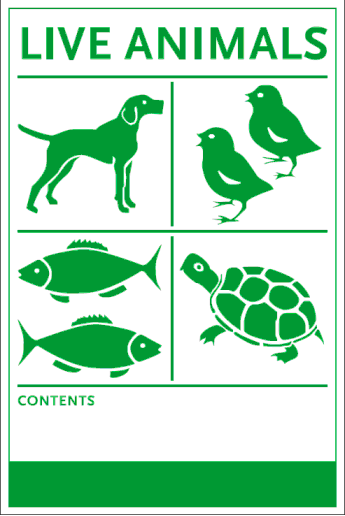
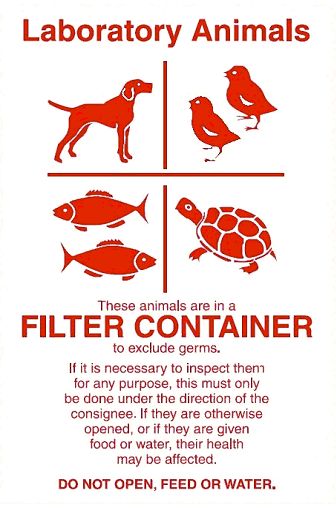
Cargo placement

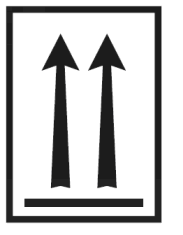
The responsible person at the acceptance point must always have the labels mentioned above available for U6 flights.
Acceptance of animals for transportation
- A Live Animals Checklist must be used for preliminary inspection of the animal and documents required for transportation prior to loading on board. The Checklist is used to verify compliance with the Rules. A sample is provided in Appendix C6.2.
- Checklists must be updated in accordance with IATA requirements. Personnel must use only updated IATA Checklists published in the Rules if U6 Checklists are unavailable. Authorized agents may use either Ural Airlines Checklists or any other form that complies with the current IATA Live Animals Regulations.
- Only specially trained CHA/GHA personnel with relevant knowledge may accept cargo using Checklists. The Checklist is prepared in two copies: original accompanies the air waybill; copy remains with the carrier.
- If ANY answer on the Checklist is “NO”, the cargo must not be accepted for transport.
Inspections by responsible personnel during handling
Visual inspections of the animal and container must be performed if it does not disturb the animal.
Disturbing the animal is permitted in cases of:
- Inspection of the animal by the responsible person;
- Export: unloading of the animal from warehouse storage;
- Processing of transfer cargo by warehouse staff.
Note. Veterinary control is carried out to verify identification (comparing the animal with documents), assess animal condition, and compliance with veterinary laws of relevant countries. The veterinarian must also ensure necessary animal treatment; if necessary, decide on sedation or euthanasia.
Record keeping
All documents for live animals must be stored at the departure airport for at least 3 months after the flight transporting the live animals:
- Original Certificate;
- Copy of Checklist;
- Copy of air waybill;
- All documents attached to transport documents;
- Copy of Feeding Instructions;
- Incident report (for 2 years — if applicable).
Transport documents
Transportation of live animals on U6 flights must also comply with general requirements described in this Manual.
-
Air waybill
- In the “Description of Goods” column — common name of the animal and AVI code; number of heads and number of pieces;
- In the “Additional Information” column — emergency phone number, description of sedative.
- Shipper’s Certificate for Live Animals. A sample is given in Appendix C6.3.
-
The Certificate must be in two copies, completed and signed by the shipper or his agent in accordance with the Rules (1 original accompanies the cargo to destination — attached to the AWB); an IATA agent, consolidator, or forwarder may not be the shipper’s agent.
Only English is used. English text may be accompanied by an exact translation in another language.
The shipper must provide detailed description of the animal and container requirements; scientific names may be omitted for cats, dogs, and animals not covered by CITES.
- Valid animal passport or Health Certificate.
- Export, import, or transit permit.
- CITES permit.
- Original Feeding Instructions must be placed inside the container; a copy must be attached to the waybill.
Note. In the “Nature of Goods” field, only Live animals may be indicated on a single AWB. Request for transportation — see Chapter 4 Section B; NOTOC — Chapter 1 Section C.
Koltsovo Airport
- Veterinary clinic certificate on vaccinations, absence of worms and skin disease — within 3 days before departure;
- From the kennel club — “Certificate of no breeding value” (if not a member, contact SODOLS club, Lenina 5);
- Pass certificate from city veterinary control, Form № …;
- Agricultural office. Regional veterinary service. R. Luxemburg Str., 60-422;
- Airport “Koltsovo”. Veterinary control. Info: (343) 226-88-96.
The certificate issued by veterinary control is valid for 5 days.
Note. Failure to comply with the above requirements results in refusal of transportation and the need to fill out new documents.
Appendix C6.1
CITES Certificate (sample)
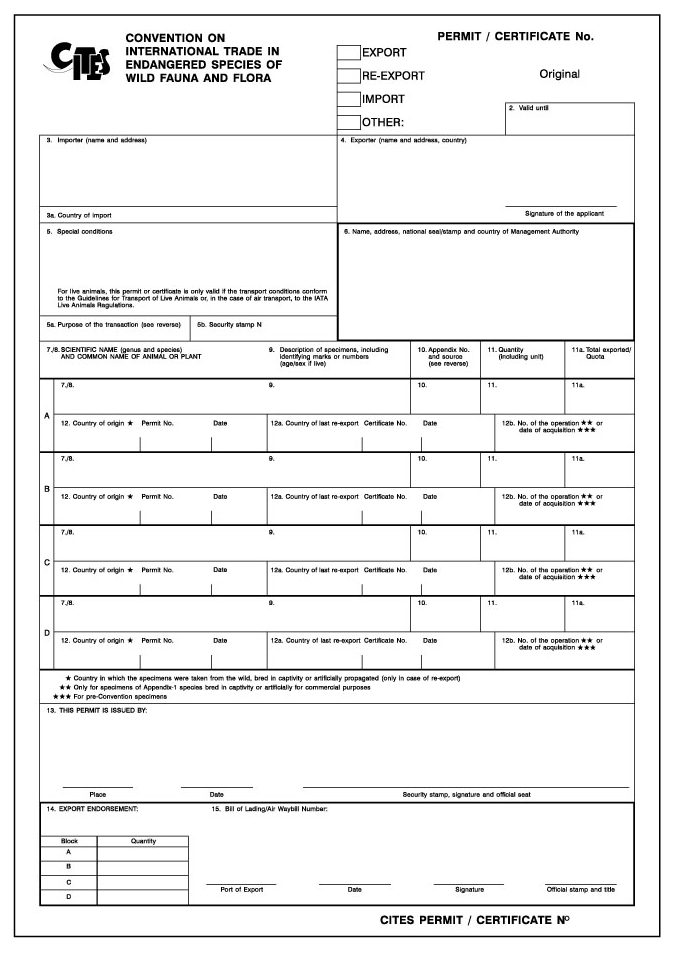
Appendix C6.2
Live Animals Checklist
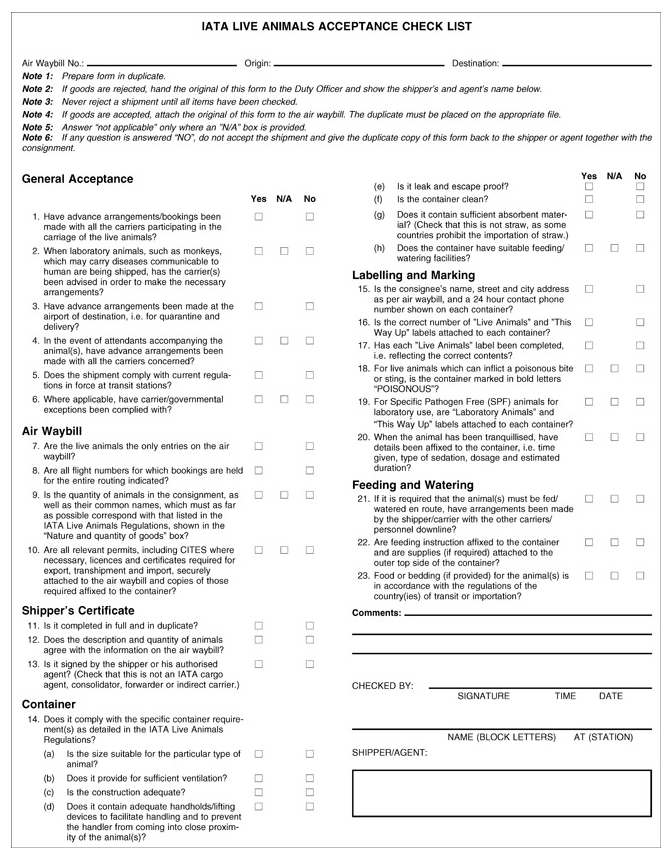
Appendix C6.3
Shipper’s Certificate for Live Animals (sample)

Shipper’s Certificate for Live Animals (sample)

